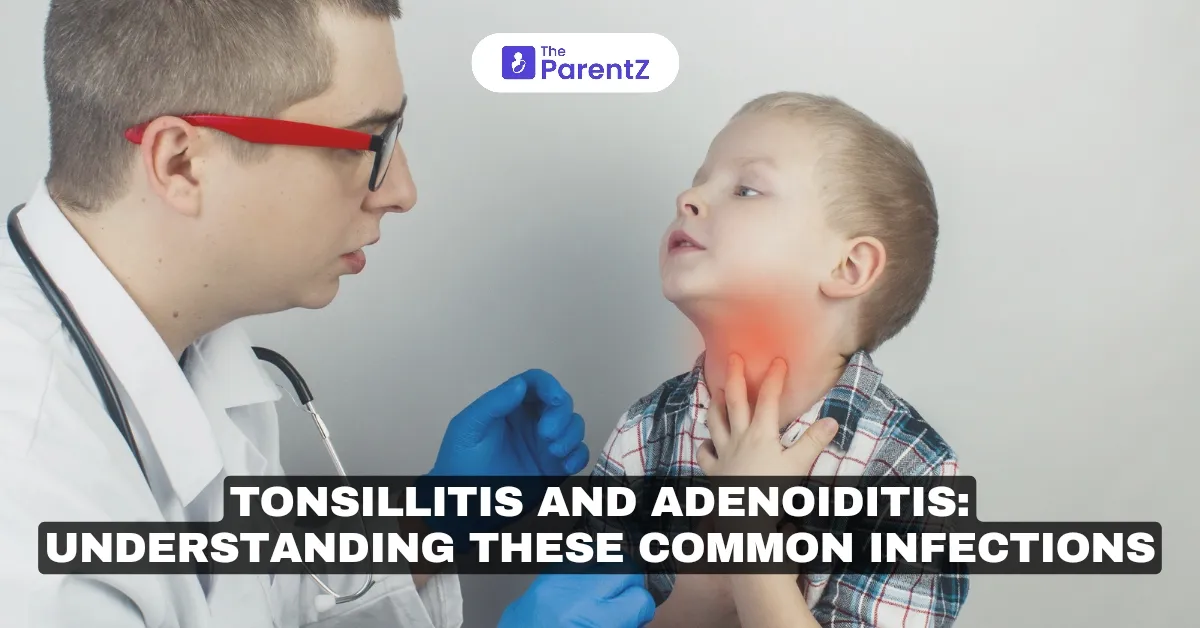Tonsillitis and adenoiditis are common childhood infections that affect the throat and nasal passages. While they can occur separately, these conditions often go hand in hand, leading to discomfort and other complications. Understanding their symptoms, causes, and treatments can help parents manage these conditions effectively.
What Are Tonsillitis and Adenoiditis?
• Tonsillitis:
Inflammation of the tonsils, two oval-shaped lymphoid tissues located at the back of the throat.
• Adenoiditis:
Inflammation of the adenoids, lymphoid tissue located behind the nasal cavity.
Both play a role in fighting infections, particularly in young children, but they can become infected themselves.
Symptoms of Tonsillitis and Adenoiditis
Tonsillitis Symptoms:
• Sore throat
• Difficulty swallowing
• Red and swollen tonsils, sometimes with white patches
• Fever
• Swollen lymph nodes in the neck
• Bad breath
Adenoiditis Symptoms:
• Nasal congestion or obstruction
• Difficulty breathing through the nose
• Snoring or sleep apnea
• Ear pain or recurrent ear infections
• Nasal discharge
Causes of Tonsillitis and Adenoiditis
1. Viral Infections:
• The most common cause, including viruses like the common cold, influenza, and Epstein-Barr virus.
2. Bacterial Infections:
• Group A Streptococcus (Strep throat): A common bacterial cause of tonsillitis.
• Other Bacteria: May lead to adenoiditis, often alongside ear infections.
3. Allergies:
• Allergic reactions can cause chronic inflammation of the adenoids.
Risk Factors
• Age:
• Common in children aged 2–6 years due to underdeveloped immune systems.
• Exposure to Germs:
• Frequent exposure to infections at school or daycare.
• Family History:
• A genetic predisposition to recurrent tonsil or adenoid infections.
Diagnosis
Healthcare providers diagnose these conditions based on:
• Physical Examination: Checking for swollen tonsils or adenoids.
• Throat Swab Test: To identify bacterial infections, such as strep throat.
• X-rays or Nasal Endoscopy: To assess the size and condition of the adenoids.
Treatment Options
1. Home Remedies and Supportive Care:
• Rest and hydration
• Warm saltwater gargles for sore throat relief (not for very young children)
• Over-the-counter pain relievers (acetaminophen or ibuprofen)
• Humidifiers to ease breathing
2. Medications:
• Antibiotics: Prescribed for bacterial infections like strep throat.
• Nasal Steroid Sprays: To reduce inflammation in adenoiditis.
3. Surgical Intervention:
• Tonsillectomy: Removal of the tonsils, recommended for recurrent or severe tonsillitis.
• Adenoidectomy: Removal of the adenoids, especially for chronic adenoiditis or sleep apnea.
• Tonsillectomy and Adenoidectomy (T&A): Sometimes performed together if both tissues are frequently infected.
Complications
If left untreated, tonsillitis and adenoiditis can lead to:
• Recurrent Infections: Chronic sore throats or nasal congestion.
• Obstructive Sleep Apnea: Interrupted breathing during sleep due to enlarged tonsils or adenoids.
• Spread of Infection: May cause abscesses or spread to nearby areas, like the ears (otitis media).
Prevention Tips
1. Good Hygiene Practices:
• Encourage handwashing and avoid sharing utensils or cups.
2. Strengthen Immunity:
• Provide a balanced diet rich in fruits, vegetables, and whole grains.
3. Vaccination:
• Ensure your child is up to date on vaccines to prevent viral infections.
4. Address Allergies:
• Manage allergies to reduce chronic inflammation.
When to See a Doctor
Consult a healthcare provider if your child:
• Has severe throat pain or difficulty swallowing.
• Experiences breathing difficulties, especially during sleep.
• Has persistent fever or signs of dehydration.
• Develops recurrent infections despite treatment.
Conclusion
Tonsillitis and adenoiditis are common and often manageable conditions in children. Early identification and appropriate treatment can alleviate symptoms and prevent complications. Parents can play an active role in prevention through good hygiene, healthy habits, and timely medical intervention. If your child shows signs of recurring infections or breathing issues, consult a doctor to discuss the best course of action.
References:
• American Academy of Pediatrics. Tonsillitis and Adenoiditis Management.
• Mayo Clinic. Tonsillitis: Symptoms and Causes.
• National Institute on Deafness and Other Communication Disorders (NIDCD). Adenoid Health.








Be the first one to comment on this story.